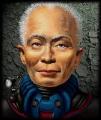 MagicJuggler wrote:
MagicJuggler wrote:How do Squig Hoppers actually work, given that they are a unit of Random Movement Skirmishers that although ITP, can be routed in close combat?
1) Can they Reform freely due to being Skirmishers? Or does the Random Move's "pivot the whole unit then move straight forward" completely nullify this?
IMO, the most logical solution is to let them move straightforward, then reform afterwards, provided any models do not move more than twice the distance of their
3d6 movement.
Unless you charged, you do it as part of your movement.
2) When a unit rallies, it immediately reforms but cannot move otherwise. Does the fact Random Movement mean they *must* move override this restriction?
Nope. They still can't do anything other than reform because rally prevents them from moving.
3) Since they RAW don't actually declare a charge, do they "contract" should their move bring them into contact with an enemy unit?
It's still treated as a charge even if they don't declare it so contract, maximise, etc. as if they had declared it.
4) What happens if they clip an enemy unit, only for contracting their ranks around the center to result in them not actually being able to reach said enemy unit? Inversely, what happens if they end up in contact with an enemy after widening their ranks in the "remaining moves subphase?"
Very hard to happen in the actual table (such as another unit or terrain piece getting in the way) but technically you can't perform the charge and stop 1'' away.
In the second example you can't contact another unit outside of a charge, so most likely you'd be expanding the other way. If not possible you should be nudging the other unit. It's one of those things each
TO would have ruled it differently.